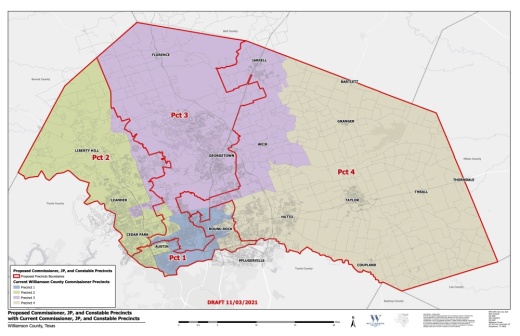"It was a very accelerated timeline," Precinct 2 Commissioner Cynthia Long said. "It started with the federal government delay in releasing the census data. That normally happens in March, but didn't come out until August."
Long, along with Precinct 3 Commissioner Valerie Covey, was a Williamson County commissioner in 2010, the last time the county went through redistricting, and that experience helped them move the process along this year, they said.
Following the delay in finalizing the nationwide census numbers, the state of Texas went through its own redistricting process that did not finish until Oct. 25.
Then, on Nov. 4, the state told its counties they had until Nov. 13 to finish their own process.
After the 2020 census, Williamson County saw its population at 609,017, a 44% jump from the 2010 total of 422,679. According to Long, most of that growth happened on the west side of the county, leaving precincts 2 and 3 over their target population of about 152,000 to evenly split the four—give or take 10%, per the U.S. Supreme Court's ruling in Brown v. Thomson.
To get their numbers in line, the commissioners, with help from a subcommittee and county staff, examined the data and proposed new boundaries for residents to know who their commissioner, justice of the peace and constable would be.
"All of our big cities are really too big to be wholly contained in one precinct," Long said. "We recognized that and knew that it wasn't feasible, for instance, for all of Georgetown to be under one commissioner anymore."
Where previously Georgetown was entirely in Precinct 3, come Jan. 1, the east side of the city will mostly be in Precinct.4, with the rest remaining in Precinct 3. Round Rock was mostly split into precincts 1 and 4, but parts of the city will also be in Precinct 3 going forward. Precinct 2 will now predominantly contain Cedar Park and Leander. Precinct 1, with parts of the city of Austin, will have a slight population edge—though within the mandated 10% margin—but is viewed as slower-growing than the other areas because it lacks the room to grow, according to Long.
"We hope that in four or five years from now, as those other precincts grow, the numbers won't skew so quickly," Long said. "We overpopulated Precinct 1 and underpopulated the others so that in five or six years it's not quite so out of balance."
While Leander more than doubled in size between censuses from 26,521 to 59,202 residents, and Cedar Park saw a 59% jump from 48,937 to 77,595, Round Rock saw an increase just shy of 20% from 99,887 to 119,468.
After receiving public comments, the final map received minor edits from the proposed map, primarily to clean up some boundary lines and ensure some areas were not split into different school districts in an attempt to help elections officials keep ballots streamlined.
"There were some tweaks that needed to be made, some cleanup," Covey said at a special meeting Nov. 12. "There were a couple of items for school districts. ... There were those [types of] changes made."
While the precinct lines are newly drawn and adopted, the county still needs to approve voting precincts in the coming weeks so political parties can elect party chairs, whose filing deadline to run is in January.
"We're still not 100% done," Long said. "We still have to draw and adopt voting precincts."





